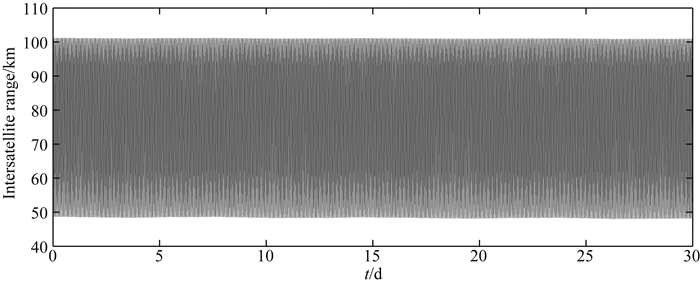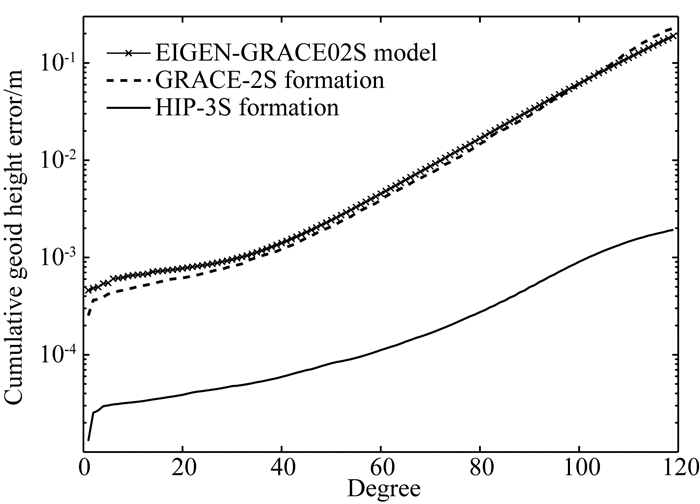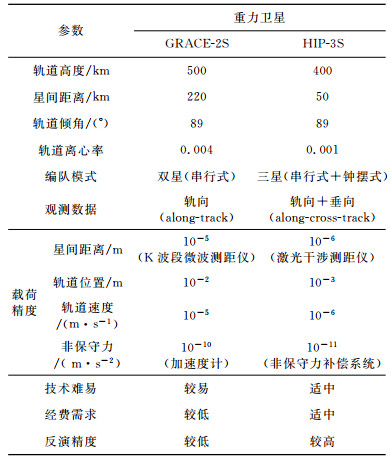2. 中国科学院测量与地球物理研究所大地测量与地球动力学国家重点实验室, 武汉 430077
2. State Key Laboratory of Geodesy and Earth's Dynamics, Institute of Geodesy and Geophysics, Chinese Academy of Sciences, Wuhan 430077, China
卫星重力测量计划是继美国全球定位系统(GPS)星座成功构建之后在大地测量领域的又一项创新和突破,是当前地球重力场探测研究中最高效、最经济和最有发展潜力的方法和技术.但目前单编队卫星重力计划(如GRACE(Gravity Recovery and Climate Experiment)串行式(Reigber et al., 2005; 张捍卫等, 2004; 沈云中等, 2005; Tapley et al., 2005; 程芦颖和许厚泽, 2006; 郑伟等, 2006, 2008, 2009a; 周旭华等, 2006; Xu, 2008; Zheng et al., 2011, 2012a, 2012b; 郑伟, 2015))的缺点是无法同时提高卫星观测数据的空间分辨率和时间分辨率.据海森堡测不准原理(HUP: Heisenberg Uncertainty Principle)可知:卫星观测数据的空间分辨率SR和时间分辨率TR的乘积为常数,
第一,下一代双星编队卫星重力计划主要包括:(1) 串行式双星编队(如美国GRACE Follow-On卫星重力计划(Stephens et al., 2006; Flechtner et al., 2009; Zheng et al., 2009b; 郑伟等, 2010c, 2012b, 2014a, 2014b; Loomis et al., 2012)、欧洲NGGM(Next-Generation Gravimetry Mission)卫星重力计划(Anselmi et al., 2010; Cesare et al., 2010; Silvestrin et al., 2012)等);(2) 钟摆式双星编队(如E.MOTION(Earth System Mass Transport Mission)卫星重力计划(Elsaka et al., 2012; Gruber et al., 2012; Panet et al., 2013; Zheng et al., 2014)等).优点:① 适当降低了卫星轨道高度(250~400 km),进而有效抑制了地球重力场信号强度随卫星轨道高度升高的衰减效应;② 适当提高了关键载荷的测量精度(1~3个数量级),进而降低了卫星观测数据误差对地球重力场反演精度的负面影响;③ 适当缩短了星间距离(50~100 km),进而提高了地球中短波重力场的感测灵敏度.缺点:① 由于随着卫星轨道高度每降低100 km,作用于卫星体的非保守力约增大一个数量级,因此不稳定的卫星工作平台不仅将影响载荷的测量精度和动态范围,而且将缩短卫星的飞行寿命,进而影响地球静态和时变重力场的反演精度;② 在提高载荷测量精度的同时,载荷技术难度、研制经费需求、以及对卫星平台的姿态控制等将大幅度增加;③ 当缩短星间距离,虽然可适当提高地球中短波重力场的测量精度,但由于双星距离太近将同时损失地球长波重力场的反演精度;④ 由于仍采用单编队卫星重力测量计划,因此无法较好解决进一步提高地球重力场空间分辨率的关键问题.
第二,下一代四星编队卫星重力计划主要包括:(1) 转轮式四星编队(如美国FSCF(Four-Satellite Cartwheel Formation)卫星重力计划(Wiese et al., 2009; 郑伟等, 2013, 2015)等);(2) 不同轨道倾角组合式四星编队(Different-Inclinations-4S Formation)(Bender et al., 2008; Zheng et al., 2008; Wiese et al., 2012).优点:① 可同时测量地球重力场的水平重力梯度和垂直重力梯度,因此有利于同时提高地球静态和时变重力场的空间分辨率,进而有效降低南北向条带误差(Striping error)的负面影响;② 由于适当升高轨道倾角有利于提高地球引力位带谐项系数精度,适当降低卫星轨道倾角有利于提高地球引力位田谐项系数精度,因此采用两组高低轨道倾角卫星组合,有利于同时提高地球引力位带谐项和田谐项系数精度.缺点:由于采用四星编队模式,因此不仅对载荷研制和卫星平台的技术要求较高,而且整体研究经费需求较大.
如图 1所示,O-XYZ表示地心惯性坐标系(ECI),原点O位于地球的质心,X轴指向地球平春分点方向,Z轴指向地球自转轴方向,Y轴与X和Z轴成右手螺旋法则.o-xyz表示卫星轨道坐标系,原点o位于卫星的质心,x轴指向卫星运动方向(along-track),y轴指向垂直于轨道面方向(cross-track),z轴由地心指向外(radial).如图 1和表 1所示,下一代HIP-3S-A/B/C三星编队预期采用近圆、近极和低地球轨道,利用高轨GNSS(Global Navigation Satellite System)星座(如美国GPS、俄罗斯GLONASS、欧洲Galileo、中国Compass等)精密跟踪低轨HIP-3S-A/B/C三星(定轨精度优于10-2 m),基于激光干涉测距仪(ILRS: Interferometric Laser Ranging System)高精度感测星间距离(10-6~10-8 m),通过非保守力补偿系统(DFCS: Drag-Free Control System)精确消除作用于HIP-3S-A/B/C三星的非保守力(10-11~10-13 m·s-2).相对于目前已提出的双星编队卫星重力计划(串行式、钟摆式等)和四星编队卫星重力计划(车轮式、不同轨道倾角组合式等),下一代HIP-3S-A/B/C三星编队卫星重力计划的特点如下:

|
图 1 下一代HIP-3S-A/B/C三星编队测量原理 Fig. 1 Measurement principle of the next-generation HIP-3S-A/B/C formation |
|
|
表 1 当前GRACE-2S双星编队和将来HIP-3S三星编队对比 Table 1 Comparison of current GRACE-2S and future HIP-3S formations |
第一,(1) 基于HIP-3S-A/B串行式双星编队精确测量轨向(along-track)地球重力场信号,通过HIP-3S-A/C钟摆式双星编队实时感测垂向(cross-track)地球重力场信号;(2) 由于可同时获得轨向和垂向重力场信号,因此相对于双星编队卫星重力计划可较大程度提高卫星观测数据的空间分辨率,有利于进一步提高地球静态和时变重力场模型的精度.
第二,(1) 采用双星编队卫星重力计划虽然可适当降低研制技术要求和减少研究经费需求,但无法同时提高卫星观测数据的空间分辨率;(2) 采用四星编队卫星重力计划虽然可较好满足下一代卫星重力反演的空间分辨率(优于100 km)需求,但由于关键载荷、卫星平台等的技术要求较高,以及需要投入的研究经费较多,因此在实际操作时较为困难;(3) 为了有效克服双星和四星编队卫星重力计划的缺点,下一代HIP-3S-A/B/C三星编队卫星重力计划,不仅可适当降低研制技术难度和研究经费,而且可同时获得较优的卫星观测数据空间分辨率,有利于较大程度减弱南北向条带误差效应,旨在建立下一代高精度、高空间分辨率和高阶次的地球静态和时变重力场模型.
第三,(1) 在双星编队中,串行式编队(GRACE Follow-On、NGGM计划等)的技术复杂性低于钟摆式编队(E.MOTION计划等);(2) 在四星编队中,转轮式编队(FSCF计划等)的技术复杂性高于不同倾角组合式编队(Bender计划等);(3) 下一代HIP-3S-A/B/C三星编队的技术复杂性高于双星编队,而低于四星编队.
Elsaka和Ilk(2009)利用短弧积分法首次开展了基于将来GRACE-Pendulum-3S编队反演地球重力场的研究论证.短弧积分法的主要优点为相对于动力学法计算速度较快;缺点为由于轨道积分弧长设计较短(约30 min),因此地球长波重力场反演精度较低(Mayer-Gürr, 2006).不同于前人的已有研究,为了揭示不同卫星重力反演法对地球重力场测量精度的影响,本文建立了新型扰动星间距离观测方程,并围绕下一代HIP-3S编队开展了探索性研究.
2 扰动星间距离观测方程在地心惯性系中,基于牛顿插值原理,单星轨道位置矢量r的泰勒展开表示为(Reubelt et al., 2003):

|
(1) |
其中,

单星参考轨道位置矢量r的泰勒展开表示为

|
(2) |
基于公式(1)—(2),单星扰动轨道位置矢量Δr的泰勒展开表示为

|
(3) |
其中,Δr=r-r.
通过公式(3) 的二阶导数,单星扰动轨道加速度矢量

|
(4) |
其中,
基于公式(4),双星扰动轨道加速度矢量差

|
(5) |
其中,Δr12=r12-r12,r12=r2-r1和r12=r2-r1分别表示轨道位置矢量差和参考轨道位置矢量差,r1和r2分别表示双星的轨道位置矢量,r1和r2分别表示双星的参考轨道位置矢量;






在公式(5) 中,双星扰动轨道加速度矢量差

|
(6) |
其中,e12=r12/|r12|表示由第一颗卫星指向第二颗卫星的单位矢量.
由于当前GPS定轨精度的限制,在卫星观测方程(6) 中直接采用Δr12无法实质性提高地球重力场的反演精度.因此,在公式(6) 中引入激光干涉测距仪的高精度扰动星间距离观测量Δρ12=ρ12-ρ12(ρ12和ρ12分别表示星间距离和参考星间距离)是建立下一代高精度和高空间分辨率地球重力场模型的关键因素.扰动星间距离观测量对卫星重力反演精度的敏感性优于星间距离观测量的原因如下:基于差分原理,星间距离ρ12和参考星间距离ρ12的共同误差可被有效差分掉,因此扰动星间距离小量Δρ12=ρ12-ρ12对地球重力场反演精度的灵敏度更高.
在公式(6) 中,扰动轨道位置矢量差Δr12可变形为

|
(7) |
其中,Δr12‖=(Δr12·e12)e12表示Δr12的视线分量,Δr12⊥=Δr12-(Δr12·e12)e12表示Δr12的垂向分量.
为了有效降低视线分量误差σ(e12·Δr12‖),本文利用Δρ12e12替代公式(7) 中的(Δr12·e12)e12.因此,公式(6) 可变形为

|
(8) |
其中,Δrρ12(tξ)=Δρ12(tξ)e12(tξ)+{Δr12(tξ)-[Δr12(tξ)·e12(tξ)]e12(tξ)}.
在公式(8) 中,

|
(9) |
其中,




|
(10) |
其中,
通过将公式(9) 和(10) 代入公式(8),扰动星间距离观测方程表示为

|
(11) |
其中,T12=T2-T1表示地球扰动位差,地球扰动位T(r, θ, λ)表示为

|
(12) |
其中,r、θ和λ分别表示地心半径、地心余纬度和地心经度;


地球引力位系数精度公式表示为(郑伟, 2015):

|
(13) |
其中,

累积大地水准面误差公式表示为

|
(14) |
如图 2所示,本文首先利用9阶Runge-Kutta线性单步法结合12阶Adams-Cowell线性多步法数值积分公式模拟了HIP-3S-A/B/C三星的轨道位置和轨道速度,开普勒轨道模拟参数如表 2所示.在轨道模拟和重力反演过程中(郑伟, 2015),本文不仅计算了保守力效应(日月引力、地球固体潮、大气潮和极潮等)(Petit and Luzum, 2010)和非保守力效应(大气阻力、太阳光压、地球辐射压、轨道和姿态控制力等)(Roesset, 2003),同时考虑了时变背景力模型效应,主要包括:海潮模型误差(FES2004模型(Lyard et al., 2006)与EOT11a模型(Savcenko and Bosch, 2011)之差)、非潮汐海洋模型误差(OMCT模型(Dobslaw et al., 2012)与ECCO模型(Gross et al., 2003)之差)、非潮汐大气模型误差(ECMWF模型(Renfrew et al., 2002)与NCEP模型(Kistler et al., 2001)之差)和全球陆地水储量模型误差(CPC模型(Fan and van den Dool, 2004)与GLDAS模型(Rodell et al., 2004)之差).

|
图 2 HIP-3S-A/B/C三星编队轨道(1天) (a) HIP-3S-A/B串行编队;(b) HIP-3S-A/C钟摆编队. Fig. 2 Orbits of HIP-3S-A/B/C formation in one day (a) HIP-3S-A/B inline formation; (b) HIP-3S-A/C pendulum formation. |
|
|
表 2 HIP-3S-A/B/C三星编队的开普勒轨道根数 Table 2 Keplerian orbital elements of three HIP-3S-A/B/C satellites |
图 3表示下一代HIP-3S-A/C钟摆编队在30天内的星间距离变化范围,统计结果如表 3所示.研究结果表明:HIP-3S-A/C钟摆编队的星间距离(波峰+波谷)的最大变化量为0.5 km,漂移率(相对变化量)为0.5 km/50 km=1%.因此,下一代HIP-3S三星编队的轨道稳定性较优,有利于提高地球重力场的反演精度.

|
图 3 HIP-3S-A/C钟摆编队的星间距离变化范围(30天) Fig. 3 Changes in inter-satellite range measurements of the HIP-3S-A/C pendulum formation in 30 days |
|
|
表 3 在30天内的HIP-3S-A/C钟摆编队的星间距离统计 Table 3 Statistics of intersatellite ranges from the HIP-3S-A/C pendulum formation in thirty days |
如图 4所示,十字线表示德国GFZ公布的120阶GRACE(EIGEN-GRACE02S模型)地球重力场的实测精度,在120阶处反演累计大地水准面精度为1.893×10-1m.虚线表示基于扰动星间距离法,利用卫星轨道参数(轨道高度500 km、星间距离220 km、轨道倾角89°和轨道离心率0.001) 和卫星关键载荷精度(星间距离10-5 m、轨道位置10-2 m、轨道速度10-5 m·s-1和非保守力10-10 m·s-2),反演120阶GRACE-2S地球重力场的模拟精度;实线表示通过扰动星间距离法,基于卫星轨道参数(表 2)和卫星关键载荷精度(星间距离10-6 m、轨道位置10-3 m、轨道速度10-6 m·s-1和非保守力10-11 m·s-2),反演120阶HIP-3S地球重力场的模拟精度;在120阶处反演GRACE-2S和HIP-3S累计大地水准面精度为2.271×10-1 m和1.923×10-3 m,在各阶处的累计大地水准面精度统计结果如表 4所示.研究结果表明:

|
图 4 基于当前GRACE-2S和下一代HIP-3S卫星编队反演累计大地水准面精度对比 Fig. 4 Comparison of cumulative geoid height errors based on current GRACE-2S and next-generation HIP-3S formations |
|
|
表 4 GRACE-2S和HIP-3S累计大地水准面精度的统计结果 Table 4 Statistics of cumulative geoid height errors from GRACE-2S and HIP-3S |
第一,① 在地球重力场长波段(2 < L≤100),基于当前GRACE-2S编队反演地球重力场的模拟精度高于地球重力场模型EIGEN-GRACE02S的实测精度.② 在地球中长波重力场(100 < L≤120),GRACE-2S地球重力场的模拟精度低于EIGEN-GRACE02S模型的实测精度.③ 在120阶内,由于利用GRACE-2S编队反演地球重力场的模拟精度(虚线)平均符合于EIGEN-GRACE02S模型的实测精度(十字线),因此可有效验证本文采用的卫星重力反演软件程序是可靠的.
第二,① 由于GRACE卫星未携带非保守力补偿系统,因此作用于卫星体的非保守力的负面影响制约了轨道高度(500 km)无法实质性降低,进而限制了GRACE地球重力场的反演精度.② 由于GRACE卫星选择搭载较低精度的K波段微波测距仪测量星间距离(10-5m),因此关键载荷误差是影响GRACE地球重力场测量精度的重要因素.③ 由于GRACE采用双星串行式编队模式,仅能测量轨向(along-track)重力场信号,无法获得垂向(cross-track)和经向(radial-track)重力场信号,因此南北向的条带误差效应限制了地球时变重力场的反演精度(图 5a).

|
图 5 基于当前GRACE-2S(a)和下一代HIP-3S(b)编队反演120阶全球累计大地水准面精度对比 Fig. 5 Comparison of global geoid height errors complete up to degree and order 120 between the GRACE-2S (a) and HIP-3S (b) formations |
第三,① 由于下一代HIP-3S卫星编队将携带非保守力补偿系统,因此可较大程度降低卫星轨道高度(250~400 km).但随着卫星轨道高度下降,非保守力的负面影响将导致喷气燃料的急剧消耗,进而损失卫星的工作寿命,因此将下一代HIP-3S卫星的轨道高度设计为400 km有利于同时提高地球重力场的精度和空间分辨率.② 不同于当前的GRACE双星计划,下一代HIP-3S卫星将采用更高精度的激光干涉测距仪获得星间距离(10-6~10-8)观测量,旨在进一步提高地球重力场反演精度.
第四,① 由于GRACE串行式双星编队有利于测量轨向(along-track)重力场信号,而Pendulum钟摆式双星编队敏感于垂向(cross-track)重力场信号,因此,联合GRACE串行式双星编队和Pendulum钟摆式双星编队有利于同时获得轨向和垂向的卫星观测信号,进而使地球重力场信号和误差更加各向同性和均匀化,有利于缓解南北向条带误差的负面影响以及进一步提高地球静态和时变重力场精度(图 5b).② 相对于转轮式四星编队和两组不同轨道倾角组合式四星编队,下一代HIP-3S三星编队不仅研制技术要求较低,而且更经济和易于实现,因此可作为下一代卫星重力计划的优选方案.
综上所述,由于下一代HIP-3S三星编队不仅可同时获得轨向和垂向的重力信息,而且研制费用相对较低,因此,基于HIP-3S编队有利于建立下一代高精度和高空间分辨率的全球重力场模型.
5 结论本文旨在基于新型扰动星间距离法,论证利用下一代HIP-3S三星编队提高地球重力场精度和空间分辨率的可行性.具体研究结论如下:
第一,本文新型扰动星间距离法的核心思想为将扰动轨道位置矢量差Δr12分解为视线(LOS)分量Δr12‖和垂向分量Δr12⊥.通过与视线方向的单位矢量e12点乘,垂向分量误差σ(e12·Δr12⊥)可被有效降低.为了进一步提高视线分量精度σ(e12·Δr12‖),本文引入了激光干涉测距仪的高精度扰动星间距离观测量Δρ12.
第二,检验了下一代HIP-3S三星编队的轨道稳定性.在30天内,由于星间距离的波动幅度变化较小(漂移率约为1%),因此HIP-3S三星编队较稳定,有利于保证地球重力场反演精度.
第三,基于新型扰动星间距离法精确反演了下一代HIP-3S地球重力场.在120阶处,基于下一代HIP-3S三星编队反演地球重力场精度较当前GRACE-2S双星编队的反演精度平均提高42倍.下一代HIP-3S地球重力场反演精度的提高主要来源于3方面的贡献:轨道高度降低(降低了100 km)、载荷精度提升(提高了10倍)和编队模式改变(HIP-3S三星编队).轨道高度降低和载荷精度提升的贡献主要侧重于改善地球重力场反演精度,编队模式改变的贡献主要体现于可同时获得轨向和垂向重力场信号(空间分辨率),进而有利于减弱南北向条带误差效应(图 5).因此,HIP-3S三星编队是提高下一代卫星重力反演精度和空间分辨率的优选模式.
致谢感谢编辑和匿名评审专家对本文的帮助,感谢美国宇航局(NASA)、德国航天局(DLR)、欧空局(ESA)等提供了下一代卫星重力计划的相关资料.
| Anselmi A, Cesare S, Anselmi A, et al. 2010. Assessment of a next generation mission for monitoring the variations of Earth's gravity. ESA Contract 22643/09/NL/AF, Final Report. http://www.academia.edu/7166766/Comparing_seven_candidate_mission_configurations_for_temporal_gravity_field_retrieval_through_full-scale_numerical_simulation | |
| Bender P L, Hall J L, Ye J, et al. 2003. Satellite-satellite laser links for future gravity missions. Space Science Reviews, 108(1-2): 377-384. | |
| Bender P L, Wiese D N, Nerem R S. 2008. A possible dual-GRACE mission with 90 degree and 63 degree inclination orbits.//Proceedings of the 3rd International Symposium on Formation Flying, Missions and Technologies. European Space Agency Symposium Proceedings. Noordwijk, The Netherlands: ESA. | |
| Cesare S, Mottini S, Musso F, et al. 2010. Satellite formation for a Next Generation Gravimetry Mission.//Sandau R, Roeser H P, Valenzuela A. Small Satellite Missions for Earth Observation. Berlin, Heidelberg: Springer, 125-133. | |
| Cheng L Y, Xu H Z. 2006. The rotation of the gravity potential on the Earth's gravity field recovery. Chinese J. Geophys. (in Chinese), 49(1): 93-98. | |
| Dirac P A M. 1958. The Principles of Quantum Mechanics (The International Series of Monographs on Physics 27). (4th ed). Oxford: Oxford University Press. | |
| Dobslaw H, Thomas M, Bergmann I, et al. 2012. OMCT-New time-series for oceanic mass, angular momentum and sea level variability.//EGU General Assembly 2012. Vienna, Austria, 10195. | |
| Elsaka B, Ilk K H. 2009. Simulated multiple formation flights for future gravity field recovery.//EGU General Assembly. Vienna, Austria. | |
| Elsaka B, Kusche J, Ilk K H. 2012. Recovery of the Earth's gravity field from formation-flying satellites: Temporal aliasing issues. Advances in Space Research, 50(11): 1534-1552. DOI:10.1016/j.asr.2012.07.016 | |
| Fan Y, van den Dool H. 2004. Climate Prediction Center global monthly soil moisture data set at 0.5° resolution for 1948 to present. ournal of Geophysical Research, 109: D10102. DOI:10.1029/2003JD004345 | |
| Flechtner F, Neumayer K H, Doll B, et al. 2009. GRAF—A GRACE follow-on mission feasibility study.//EGU General Assembly 2009. Vienna, Austria. | |
| Gross R S, Fukumori I, Menemenlis D. 2003. Atmospheric and oceanic excitation of the Earth's wobbles during 1980—2000. Journal of Geophysical Research, 108: 2370. DOI:10.1029/2002JB002143 | |
| Gruber T, Panet I, Johannessen J, et al. 2012. Earth system mass transport mission (e.motion): technological and mission configuration challenges.//International Symposium on Gravity, Geoid and Height Systems, GGHS2012. Venice. | |
| Kistler R, Collins W, Saha S, et al. 2001. The NCEP-NCAR 50-year reanalysis: monthly means CD-ROM and documentation. Bulletin of the American Meteorological Society, 82(2): 247-267. DOI:10.1175/1520-0477(2001)082<0247:TNNYRM>2.3.CO;2 | |
| Loomis B D, Nerem R S, Luthcke S B. 2012. Simulation study of a follow-on gravity mission to GRACE. Journal of Geodesy, 86(5): 319-335. DOI:10.1007/s00190-011-0521-8 | |
| Lyard F, Lefevre F, Letellier T, et al. 2006. Modelling the global ocean tides: modern insights from FES2004. Ocean Dynamics, 56(5-6): 394-415. DOI:10.1007/s10236-006-0086-x | |
| Mayer-Gürr T. 2006. Gravitationsfeldbestimmung aus der Analyse kurzer Bahnbögen am Beispiel der Satellitenmissionen CHAMP und GRACE [Ph. D. thesis]. Germany: University of Bonn. https://link.springer.com/chapter/10.1007/978-3-642-10228-8_13/fulltext.html | |
| Panet I, Flury J, Biancale R, et al. 2013. Earth system mass transport mission (e. motion): A concept for future earth gravity field measurements from space. Surveys in Geophysics, 34(2): 141-163. DOI:10.1007/s10712-012-9209-8 | |
| Petit G, Luzum B. 2010. IERS Conventions (2010). IERS Technical Note 36, Verlagdes Bundesamts für Kartographie und Geodäsie, Frankfurt am Main, Germany. https://link.springer.com/article/10.1007/s00190-014-0697-9 | |
| Reigber C, Schmidt R, Flechtner F, et al. 2005. An Earth gravity field model complete to degree and order 150 from GRACE: EIGEN-GRACE02S. Journal of Geodynamics, 39(1): 1-10. DOI:10.1016/j.jog.2004.07.001 | |
| Renfrew I A, Moore G W K, Guest P S, et al. 2002. A comparison of surface layer and surface turbulent flux observations over the Labrador Sea with ECMWF analyses and NCEP reanalyses. Journal of Physical Oceanography, 32(2): 383-400. DOI:10.1175/1520-0485(2002)032<0383:ACOSLA>2.0.CO;2 | |
| Reubelt T, Austen G, Grafarend E W. 2003. Harmonic analysis of the Earth's gravitational field by means of semi-continuous ephemerides of a low Earth orbiting GPS-tracked satellite. Case study: CHAMP. Journal of Geodesy, 77(5): 257-278. | |
| Reubelt T, Sneeuw N, Sharifi M. 2008. Future mission design options for spatio-temporal geopotential recovery.//Gravity, Geoid and Earth Observation. Berlin, Heidelberg: Springer, 163-170. | |
| Rodell M, Houser P R, Jambor U, et al. 2004. The global land data assimilation system. Bulletin of the American Meteorological Society, 85(3): 381-394. DOI:10.1175/BAMS-85-3-381 | |
| Roesset P J. 2003. A simulation study of the use of accelerometer data in the GRACE mission [Ph. D. thesis]. Austin: The University of Texas. https://repositories.lib.utexas.edu/handle/2152/888 | |
| Rummel R. 2003. How to climb the gravity wall. Space Science Reviews, 108(1-2): 1-14. | |
| Savcenko R, Bosch W. 2011. EOT11a—a new tide model from Multi-Mission Altimetry.//OSTST Meeting. San Diego. | |
| Shen Y Z, Xu H Z, Wu B. 2005. Simulation of recovery of the geopotential model based on intersatellite acceleration data in the low-low satellite to satellite tracking gravity mission. Chinese J. Geophys. (in Chinese), 48(4): 807-811. | |
| Silvestrin P, Aguirre M, Massotti L, et al. 2012. The future of the satellite gravimetry after the GOCE mission.//Kenyon S, Pacino M, Marti U. Geodesy for Planet Earth, International Association of Geodesy Symposia, Vol.136. Berlin, Heidelberg: Springer, 223-230. | |
| Sneeuw N, Flury J, Rummel R. 2004. Science requirements on future missions and simulated mission scenarios. Earth, Moon, and Planets, 94(1-2): 113-142. DOI:10.1007/s11038-004-7605-x | |
| Stephens M, Craig R, Leitch J, et al. 2006. Demonstration of an interferometric laser ranging system for a Follow-On gravity mission to GRACE.//Proceedings of IEEE International Conference on Geoscience and Remote Sensing Symposium. Denver, CO: IEEE, 1115-1118. | |
| Tapley B, Ries J, Bettadpur S, et al. 2005. GGM02—An improved Earth gravity field model from GRACE. Journal of Geodesy, 79(8): 467-478. DOI:10.1007/s00190-005-0480-z | |
| van Dam T, Visser P, Sneeuw N, et al. 2008. Monitoring and modelling individual sources of mass distribution and transport in the earth system by means of satellites. Final Report. ESA Contract No. 20403. https://link.springer.com/chapter/10.1007/978-3-642-32135-1_21 | |
| Wiese D N, Folkner W M, Nerem R S. 2009. Alternative mission architectures for a gravity recovery satellite Mission. Journal of Geodesy, 83(6): 569-581. DOI:10.1007/s00190-008-0274-1 | |
| Wiese D N, Nerem R S, Lemoine F G. 2012. Design considerations for a dedicated gravity recovery satellite mission consisting of two pairs of satellites. Journal of Geodesy, 86(2): 81-98. DOI:10.1007/s00190-011-0493-8 | |
| Xu P L. 2008. Position and velocity perturbations for the determination of geopotential from space geodetic measurements. Celestial Mechanics and Dynamical Astronomy, 100(3): 231-249. DOI:10.1007/s10569-008-9117-x | |
| Zhang H W, Xu H Z, Liu X Q. 2004. Basic theory and numerical result of the love number of solid Earth tide. Progress in Geophysics (in Chinese), 19(2): 372-378. | |
| Zheng W. 2015. Theory and Methodology on Satellite Gravity Recovery based on the energy Conservation Principle (in Chinese). Beijing: Science Press: 1-231. | |
| Zheng W, Hsu H T, Zhong M, et al. 2008. Efficient and rapid estimation of the accuracy of GRACE global gravitational field using the semi-analytical method. Chinese J. Geophys. (in Chinese), 51(6): 1704-1710. | |
| Zheng W, Hsu H T, Zhong M, et al. 2010c. Efficient and rapid estimation of the accuracy of future GRACE Follow-On Earth's gravitational field using the analytic method. Chinese J. Geophys. (in Chinese), 53(4): 796-806. DOI:10.3969/j.issn.0001-5733.2010.04.004 | |
| Zheng W, Hsu H, Zhong M, et al. 2012a. Efficient accuracy improvement of GRACE global gravitational field recovery using a new inter-satellite range interpolation method. Journal of Geodynamics, 53: 1-7. DOI:10.1016/j.jog.2011.07.003 | |
| Zheng W, Hsu H, Zhong M, et al. 2012b. Precise recovery of the Earth's gravitational field with GRACE: Intersatellite Range-Rate Interpolation Approach. IEEE Geoscience and Remote Sensing Letters, 9(3): 422-426. DOI:10.1109/LGRS.2011.2171475 | |
| Zheng W, Hsu H T, Zhong M, et al. 2012b. Impacts of interpolation formula, correlation coefficient and sampling interval on the accuracy of GRACE Follow-On intersatellite range-acceleration. Chinese J. Geophys. (in Chinese), 55(3): 822-832. DOI:10.6038/j.issn.0001-5733.2012.03.012 | |
| Zheng W, Hsu H T, Zhong M, et al. 2013. Precise and rapid recovery of the Earth's gravitational field by the next-generation four-satellite cartwheel formation system. Chinese J. Geophys. (in Chinese), 56(9): 2928-2935. DOI:10.6038/cjg20130907 | |
| Zheng W, Hsu H T, Zhong M, et al. 2014a. Precise and rapid recovery of Earth's gravity field from next-generation GRACE Follow-On mission using the residual intersatellite range-rate method. Chinese J. Geophys. (in Chinese), 57(1): 31-41. DOI:10.6038/cjg20140104 | |
| Zheng W, Hsu H T, Zhong M, et al. 2014b. Precise recovery of the Earth's gravitational field by GRACE Follow-On satellite gravity gradiometry method. Chinese J. Geophys. (in Chinese), 57(5): 1415-1423. DOI:10.6038/cjg20140506 | |
| Zheng W, Hsu H T, Zhong M, et al. 2014. Physical analysis on improving the recovery accuracy of the Earth's gravity field by a combination of satellite observations in along-track and cross-track directions. Chinese Physics B, 23(10): 109101. DOI:10.1088/1674-1056/23/10/109101 | |
| Zheng W, Hsu H T, Zhong M, et al. 2015a. Requirements analysis for future satellite gravity mission Improved-GRACE. Surveys in Geophysics, 36(1): 87-109. DOI:10.1007/s10712-014-9306-y | |
| Zheng W, Hsu H T, Zhong M, et al. 2015b. Sensitivity analysis for key payloads and orbital parameters from the next-generation Moon-Gradiometer satellite gravity program. Surveys in Geophysics, 36(1): 111-137. DOI:10.1007/s10712-014-9310-2 | |
| Zheng W, Hsu H T, Zhong M, et al. 2015c. Improvement in the recovery accuracy of the lunar gravity field based on the future Moon-ILRS spacecraft gravity mission. Surveys in Geophysics, 36(4): 587-619. DOI:10.1007/s10712-015-9324-4 | |
| Zheng W, Hsu H T, Zhong M, et al. 2016a. Future dedicated Venus-SGG flight mission: accuracy assessment and performance analysis. Advances in Space Research, 57(1): 459-476. DOI:10.1016/j.asr.2015.08.036 | |
| Zhou X H, Hsu H T, Wu B, et al. 2006. Earth's gravity field derived from GRACE satellite tracking data. Chinese J. Geophys. (in Chinese), 49(3): 718-723. | |
| Zheng W, Shao C G, Luo J, et al. 2006. Numerical simulation of Earth's gravitational field recovery from SST based on the energy conservation principle. Chinese J. Geophys. (in Chinese), 49(3): 712-717. | |
| Zheng W, Shao C G, Luo J, et al. 2008. Improving the accuracy of GRACE Earth's gravitational field using the combination of different inclinations. Progress in Natural Science, 18(5): 555-561. DOI:10.1016/j.pnsc.2007.11.017 | |
| Zheng W, Xu H Z, Zhong M, et al. 2009a. Effective processing of measured data from GRACE key payloads and accurate determination of Earth's gravitational field. Chinese J. Geophys. (in Chinese), 52(8): 1966-1975. DOI:10.3969/j.issn.0001-5733.2009.08.003 | |
| Zheng W, Xu H Z, Zhong M, et al. 2009b. Influence of the adjusted accuracy of center of mass between GRACE satellite and SuperSTAR accelerometer on the accuracy of Earth's gravitational field. Chinese J. Geophys. (in Chinese), 52(6): 1465-1473. DOI:10.3969/j.issn.0001-5733.2009.06.007 | |
| Zheng W, Xu H Z, Zhong M, et al. 2009c. Demonstration on the optimal design of resolution indexes of high and low sensitive axes from space-borne accelerometer in the satellite-to-satellite tracking model. Chinese J. Geophys. (in Chinese), 52(11): 2712-2720. DOI:10.3969/j.issn.0001-5733.2009.11.005 | |
| Zheng W, Xu H Z, Zhong M, et al. 2009a. Physical explanation of influence of twin and three satellite formation mode on the accuracy of Earth's gravitational field. Chinese Physics Letters, 26(2): 029101. DOI:10.1088/0256-307X/26/2/029101 | |
| Zheng W, Xu H Z, Zhong M, et al. 2009b. Accurate and rapid error estimation on global gravitational field from current GRACE and future GRACE Follow-On missions. Chinese Physics B, 18(8): 3597-3604. DOI:10.1088/1674-1056/18/8/077 | |
| Zheng W, Xu H Z, Zhong M, et al. 2010a. Research progress in international gravity satellites and future satellite gravity measurement program in China. Science of Surveying and Mapping (in Chinese), 35(1): 5-9. | |
| Zheng W, Xu H Z, Zhong M, et al. 2010b. Research on optimal selection of orbital parameters in improved-GRACE satellite gravity measurement mission. Journal of Geodesy and Geodynamics (in Chinese), 30(2): 43-48. | |
| Zheng W, Xu H Z, Zhong M, et al. 2011. Efficient calibration of the non-conservative force data from the space-borne accelerometers of the twin GRACE satellites. Transactions of the Japan Society for Aeronautical and Space Sciences, 54(184): 106-110. DOI:10.2322/tjsass.54.106 | |
| Zheng W, Xu H Z, Zhong M, et al. 2012a. Progress in international next-generation satellite gravity measurement missions. Journal of Geodesy and Geodynamics (in Chinese), 32(3): 152-159. | |
| Zheng W, Xu H Z, Zhong M, et al. 2015. A study on the improvement in spatial resolution of the Earth's gravitational field by the next-generation ACR-Cartwheel-A/B twin-satellite formation. Chinese J. Geophys. (in Chinese), 58(3): 767-779. DOI:10.6038/cjg20150307 | |
| Zheng W, Wang Z K, Ding Y W, et al. 2016b. Accurate establishment of error models for the satellite gravity gradiometry recovery and requirements analysis for the future GOCE Follow-On mission. Acta Geophysica, 64(3): 732-754. | |
| 程芦颖, 许厚泽. 2006. 地球重力场恢复中的位旋转效应. 地球物理学报, 49(1): 93–98. | |
| 沈云中, 许厚泽, 吴斌. 2005. 星间加速度解算模式的模拟与分析. 地球物理学报, 48(4): 807–811. | |
| 张捍卫, 许厚泽, 刘学谦. 2004. 固体潮Love数的基本理论和数值结果. 地球物理学进展, 19(2): 372–378. | |
| 郑伟. 2015. 基于能量守恒原理的卫星重力反演理论与方法. 北京: 科学出版社: 1-231. | |
| 郑伟, 邵成刚, 罗俊, 等. 2006. 基于卫-卫跟踪观测技术利用能量守恒法恢复地球重力场的数值模拟研究. 地球物理学报, 49(3): 712–717. | |
| 周旭华, 许厚泽, 吴斌, 等. 2006. 用GRACE卫星跟踪数据反演地球重力场. 地球物理学报, 49(3): 718–723. | |
| 郑伟, 许厚泽, 钟敏, 等. 2008. 基于半解析法有效和快速估计GRACE全球重力场的精度. 地球物理学报, 51(6): 1704–1710. | |
| 郑伟, 许厚泽, 钟敏, 等. 2009a. GRACE卫星关键载荷实测数据的有效处理和地球重力场的精确解算. 地球物理学报, 52(8): 1966–1975. DOI:10.3969/j.issn.0001-5733.2009.08.003 | |
| 郑伟, 许厚泽, 钟敏, 等. 2009b. GRACE星体和SuperSTAR加速度计的质心调整精度对地球重力场精度的影响. 地球物理学报, 52(6): 1465–1473. DOI:10.3969/j.issn.0001-5733.2009.06.007 | |
| 郑伟, 许厚泽, 钟敏, 等. 2009c. 卫星跟踪卫星测量模式中星载加速度计高低灵敏轴分辨率指标优化设计论证. 地球物理学报, 52(11): 2712–2720. DOI:10.3969/j.issn.0001-5733.2009.11.005 | |
| 郑伟, 许厚泽, 钟敏, 等. 2010a. 国际重力卫星研究进展和我国将来卫星重力测量计划. 测绘科学, 35(1): 5–9. | |
| 郑伟, 许厚泽, 钟敏, 等. 2010b. Improved-GRACE卫星重力轨道参数优化研究. 大地测量与地球动力学, 30(2): 43–48. | |
| 郑伟, 许厚泽, 钟敏, 等. 2010c. 利用解析法有效快速估计将来GRACE Follow-On地球重力场的精度. 地球物理学报, 53(4): 796–806. DOI:10.3969/j.issn.0001-5733.2010.04.004 | |
| 郑伟, 许厚泽, 钟敏, 等. 2012a. 国际下一代卫星重力测量计划研究进展. 大地测量与地球动力学, 32(3): 152–159. | |
| 郑伟, 许厚泽, 钟敏, 等. 2012b. 插值公式、相关系数和采样间隔对GRACE Follow-On星间加速度精度的影响. 地球物理学报, 55(3): 822–832. DOI:10.6038/j.issn.0001-5733.2012.03.012 | |
| 郑伟, 许厚泽, 钟敏, 等. 2013. 基于下一代四星转轮式编队系统精确和快速反演FSCF地球重力场. 地球物理学报, 56(9): 2928–2935. DOI:10.6038/cjg20130907 | |
| 郑伟, 许厚泽, 钟敏, 等. 2014a. 基于残余星间速度法精确和快速反演下一代GRACE Follow-On地球重力场. 地球物理学报, 57(1): 31–41. DOI:10.6038/cjg20140104 | |
| 郑伟, 许厚泽, 钟敏, 等. 2014b. 基于GRACE Follow-On卫星重力梯度法精确反演地球重力场. 地球物理学报, 57(5): 1415–1423. DOI:10.6038/cjg20140506 | |
| 郑伟, 许厚泽, 钟敏, 等. 2015. 基于下一代三向车轮双星编队改善地球重力场空间分辨率研究. 地球物理学报, 58(3): 767–779. DOI:10.6038/cjg20150307 | |
 2017, Vol. 60
2017, Vol. 60





